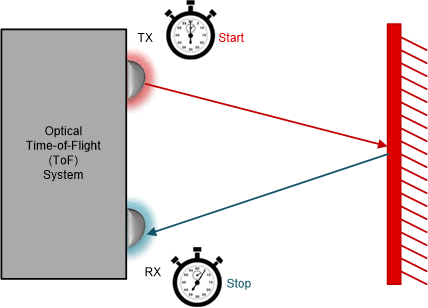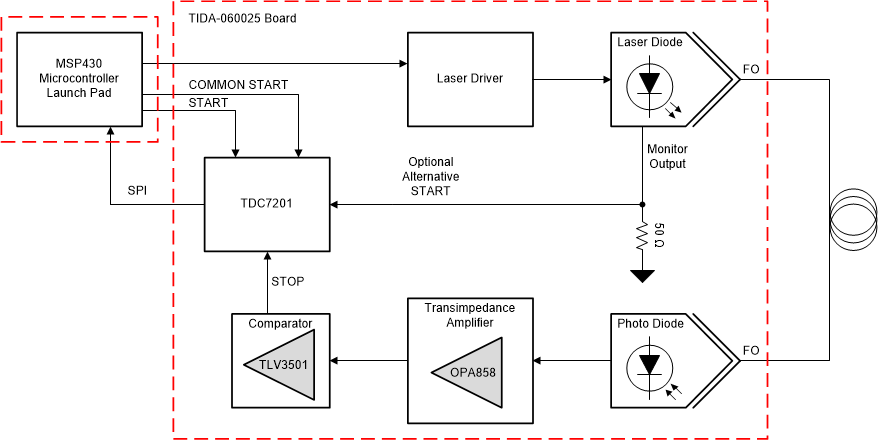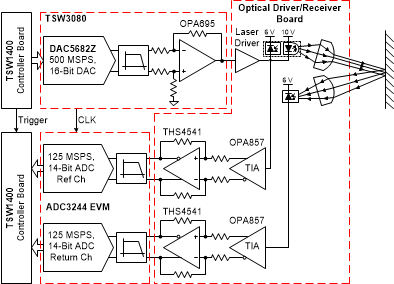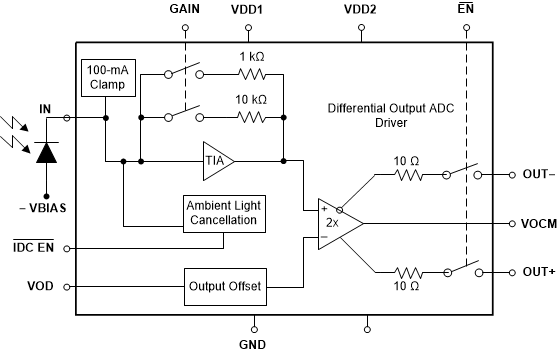SBOA337A February 2020 – April 2022 ADC12QJ1600 , ADC12QJ1600-Q1 , ADC34J45 , LMH32401 , LMH32404 , LMH32404-Q1 , LMH34400 , MSP430F5529 , OPA855 , OPA855-Q1 , OPA857 , OPA857-DIE , OPA858 , OPA858-Q1 , TDC7201 , THS4541 , TLV3501 , TLV3801
TI Tech Note
Optical Time-of-Flight (ToF) LIDAR (Light Detection and Ranging) systems are used in a wide variety of products including range finders, speed measurement devices, surveying equipment, robotics, drones, 3D mapping, and automotive advanced driver assistance systems (ADAS). Optical ToF systems consist of a light transmitter, usually in the form of a laser, and a light receiver. These systems measure distance by emitting a pulse of light onto an object and receiving the reflected pulse of light from the object. The time it takes for the light to travel to and from the object can be used to calculate the distance the between the transmitter, receiver, and the object. Figure 1-1 shows a high-level diagram of an optical ToF system.
 Figure 1-1 Optical Time-of-Flight System
Diagram
Figure 1-1 Optical Time-of-Flight System
DiagramTwo main optical ToF receive path system architectures include time-to-digital converter (TDC) based systems and analog-to-digital converter (ADC) based systems. These two architectures are both viable in implementing optical ToF systems and each comes with different advantages and tradeoffs.
A TDC-based system employs a TDC like TI’s TDC7201 device to perform a very precise stop watch function to measure the elapsed time between a start pulse and a stop pulse. Figure 1-2 shows a block diagram of this system.
 Figure 1-2 DC-Based Optical ToF System
Diagram
Figure 1-2 DC-Based Optical ToF System
DiagramA low-power microcontroller like TI’s MSP430F5529 can be used in conjunction with the TDC7201 device to initiate the transmit laser pulse and to process the ToF information collected from the TDC. The receive path also requires a transimpedance amplifier or TIA like the TI OPA858 5.5-GHz operational amplifier to perform a current-to-voltage conversion on the signal received from the photodiode. The low bias current CMOS inputs, and a low noise of 2.5 nV/√ Hz of the OPA858 device make it ideal for use as a transimpedance amplifier (TIA) in this application. Depending on the capacitance of the photodiode used in the system, the OPA858 can achieve over 250 MHz of closed-loop bandwidth with a gain of 10 kΩ. The TIA is also available in a very small 2 mm × 2 mm, 8-pin package for space-constrained or multi-channel designs to help minimize the required board space. The OPA855 device is an 8-GHz bipolar input amplifier that can also be used as a TIA that is available in a pin-to-pin compatible package to the OPA858 device. A more integrated TIA like the LMH34400 provides advantages to TDC based systems with features like ambient light cancellation.
The receive path in this system also employs comparators like TI’s TLV3501 or TLV3801 devices to receive the output of the TIA and drive the stop input of the TDC. The TLV3501 is well suited for this part of the circuit since it features a fast rise time of only 1.5 ns and a short delay of only 4.5 ns.
This TDC-based architecture is very good when low cost and low power consumption are desired and only a simple distance measurement is required. For more information about the TDC-based architecture, see the TIDA-060025 reference design and the Time of Flight & LIDAR - Optical Front End Reference Design video.
An ADC-based ToF LIDAR system employs a high-speed analog-to-digital converter like TI’s ADC34J45 14-bit 160 MSPS ADC to convert the reflected waveform to a digital signal that can be processed and analyzed. These systems usually use a digital signal processor (DSP) or a field programmable gate array (FPGA) to process the waveform information received via the ADC. These ADC-based systems can usually determine object distance and additional properties about the object like reflectivity. Figure 1-3 illustrates a block diagram of an ADC-based optical ToF of system.
 Figure 1-3 ADC-Based Optical ToF System
Diagram
Figure 1-3 ADC-Based Optical ToF System
DiagramThe receive path in this system also requires a TIA to convert the current output of the photodiode into a voltage. In this system a TI OPA857 TIA with integrated selectable gain options is used. The OPA857 device features selectable transimpedance gain options of 5 kΩ or 20 kΩ to allow for flexibility in the system design. The OPA857 is also available in a 3 mm x 3 mm, 8-pin package and in bare die form (OPA857-DIE) to enable direct wire bonding between the photodiode and the TIA. Direct wire bonding with the OPA857-DIE can significantly reduce parasitic capacitance and inductance between the photodiode and the TIA. The bare die option can also enable smaller designs and more efficient connections between the photodiode and the TIA.
The ADC-based system also uses the THS4541 fully differential amplifier (FDA) to drive the differential inputs of the ADC34J45 high-speed ADC. After the information is digitized, it is processed and analyzed by an FPGA on the TSW1400 controller board. The system then determines object distance information that is displayed on a PC-based application. For more information about the ADC-based architecture, see the TIDA-01187 reference design and the LiDAR Pulsed Time-of-Flight Reference Design Overview (TIDA-01187) video.
Texas Instruments also offers the single-channel LMH32401 and quad-channel LMH32404 state-of-the-art devices that integrates several features for optical ToF receive circuits. Figure 1-4 illustrates the LMH32401 block diagram.
 Figure 1-4 LMH32401 Simplified Block
Diagram
Figure 1-4 LMH32401 Simplified Block
DiagramThe LMH32401 device is a programmable-gain, single-ended input to differential-output transimpedance amplifier. The device can be configured with a transimpedance gain of either 2 kΩ or 20 kΩ and features an integrated single-ended to differential-output amplifier that provides up to 1.5 VPP of output swing making it ideal for driving a high-speed ADC. The LMH32401 also features an integrated 100-mA current clamp that protects the amplifier and allows it to recover rapidly from an overloaded input condition that can occur in optical distance measurement systems. The amplifier also features an integrated ambient light cancellation circuit. The Differential Output Offset Voltage (VOD) input pin of the device can be used to set the differential output between the OUT+ and OUT– pins of the device. This is extremely useful in maximizing the dynamic range of ADCs like the 1.6 GSPS ADC12QJ1600 in optical front ends. The VOD pin voltage allows the OUT– signal to be level-shifted above Output Common Mode Voltage (VOCM) and OUT+ to be level-shifted below VOCM to maximize the output swing capabilities of the amplifier. For more information about optimizing dynamic range of analog front ends, see the Analog Design Journal.
Optical ToF LIDAR systems are used in a wide variety of products and receive paths can be architected using either TDCs or ADCs. TI offers many ICs including TIAs, FDAs, TDCs and ADCs for use in these systems. For additional information about optical systems, see An Introduction to Automotive LIDAR White Paper.